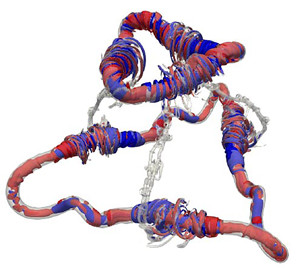Published online by Cambridge University Press: 27 July 2021

A slender trefoil knotted vortex is studied using direct numerical simulation of the Navier–Stokes equations for vortex Reynolds numbers ( $Re \equiv \varGamma /\nu$, circulation/viscosity) up to 12 000. For initially zero twist (
$Re \equiv \varGamma /\nu$, circulation/viscosity) up to 12 000. For initially zero twist ( $T_{w,0}=0$), neither the writhe
$T_{w,0}=0$), neither the writhe  $W_r$ nor the global helicity
$W_r$ nor the global helicity  $H$ is conserved. Initially
$H$ is conserved. Initially  $W_r$ slowly decreases, then suddenly drops during reconnection and becomes almost constant thence; its evolution is almost
$W_r$ slowly decreases, then suddenly drops during reconnection and becomes almost constant thence; its evolution is almost  $Re$ independent. Before reconnection,
$Re$ independent. Before reconnection,  $H$ also gradually decreases but sharply increases during reconnection. The evolution of
$H$ also gradually decreases but sharply increases during reconnection. The evolution of  $H$ after reconnection strongly depends on
$H$ after reconnection strongly depends on  $Re$. While steadily decreasing at low
$Re$. While steadily decreasing at low  $Re$,
$Re$,  $H$ significantly increases before eventually decaying at high
$H$ significantly increases before eventually decaying at high  $Re$. Flow visualization, helicity decomposition and helical wave decomposition reveal that significant amounts of positive and negative twist helicities are simultaneously generated before and during reconnection. Also, the small leading and large trailing rings resulting from asymmetric reconnection have respectively negative and positive twists, which then decay differently due to different initial values, geometries and mutual induction. In particular, at high
$Re$. Flow visualization, helicity decomposition and helical wave decomposition reveal that significant amounts of positive and negative twist helicities are simultaneously generated before and during reconnection. Also, the small leading and large trailing rings resulting from asymmetric reconnection have respectively negative and positive twists, which then decay differently due to different initial values, geometries and mutual induction. In particular, at high  $Re$, the twist in the small ring, under stretching by the large trailing ring, decays much faster and even switches sign to become positive by the writhe-to-twist conversion – the main reason for the ‘transient growth’ of
$Re$, the twist in the small ring, under stretching by the large trailing ring, decays much faster and even switches sign to become positive by the writhe-to-twist conversion – the main reason for the ‘transient growth’ of  $H$. Simulations with non-zero initial twists (
$H$. Simulations with non-zero initial twists ( $T_{w,0}=7.48$ and
$T_{w,0}=7.48$ and  $22.48$) reveal that the overall dynamics is similar to the
$22.48$) reveal that the overall dynamics is similar to the  $T_{w,0}=0$ case. Hence, the evolution of the trefoil knotted vortex is mainly governed by
$T_{w,0}=0$ case. Hence, the evolution of the trefoil knotted vortex is mainly governed by  $W_r$, not
$W_r$, not  $T_w$, although the latter is found to play an essential role in enstrophy growth as well as energy cascade.
$T_w$, although the latter is found to play an essential role in enstrophy growth as well as energy cascade.